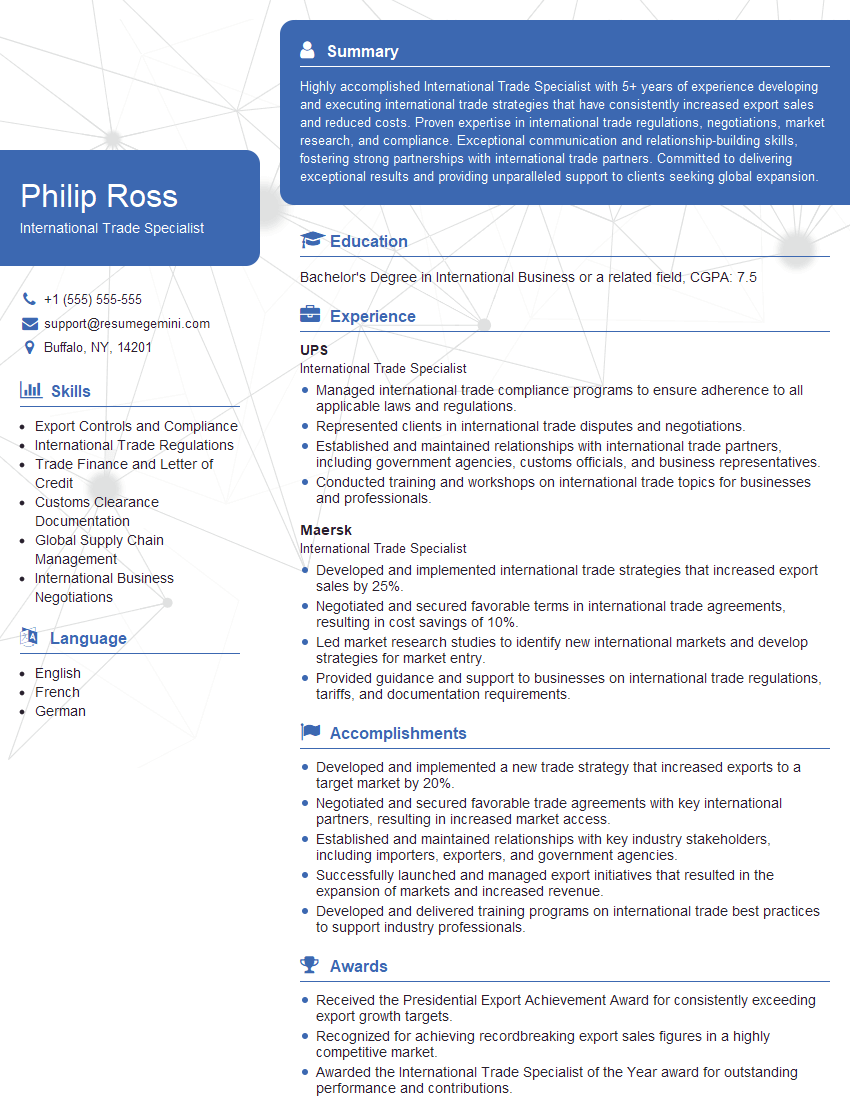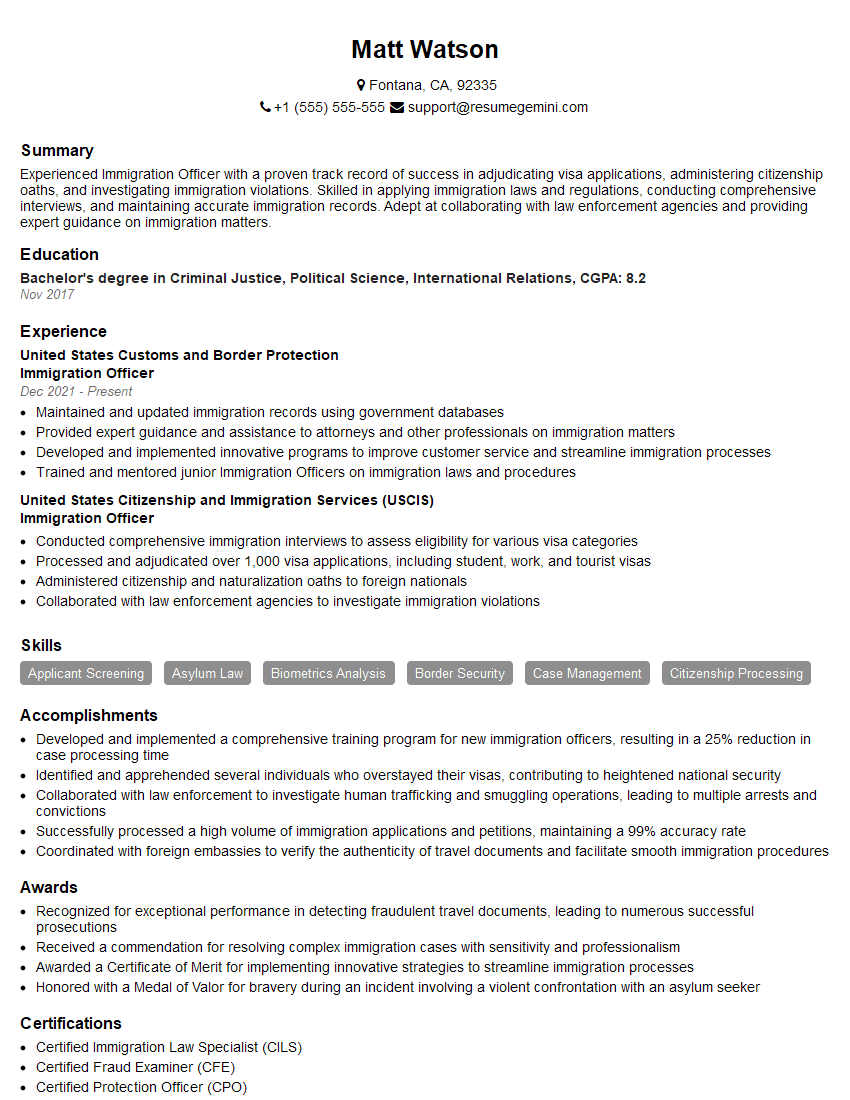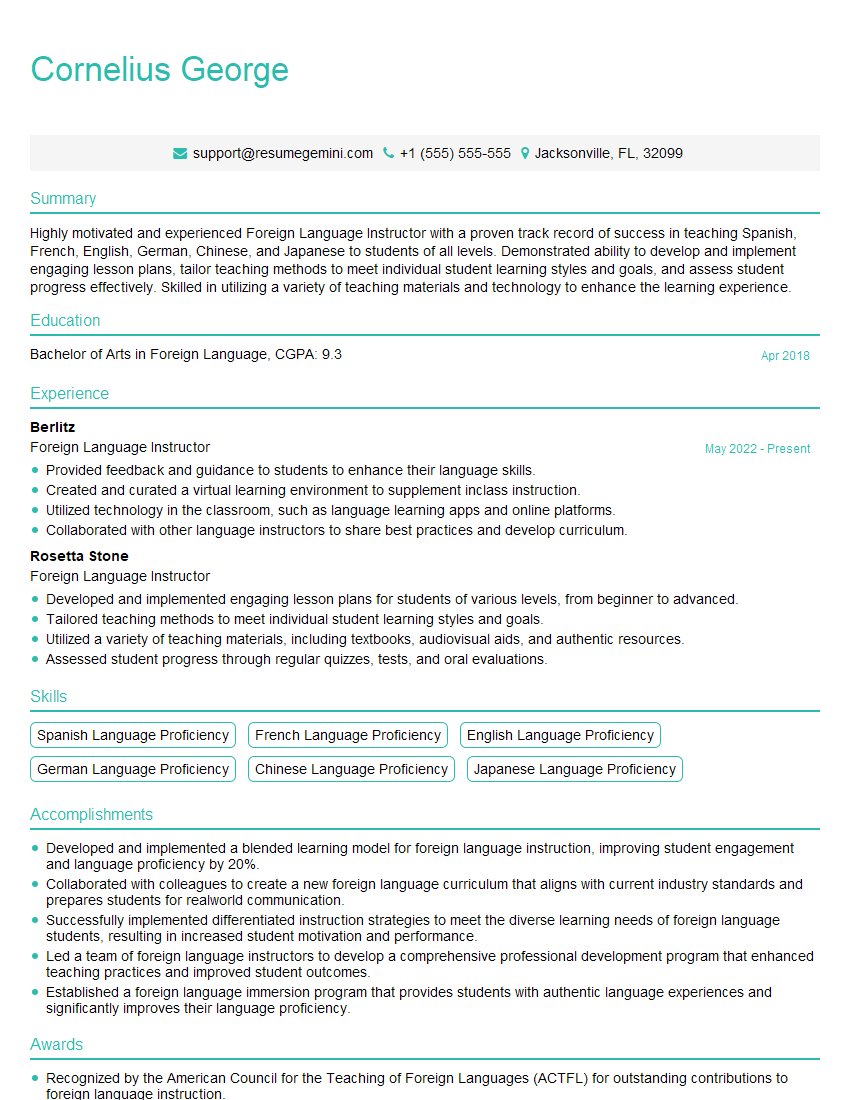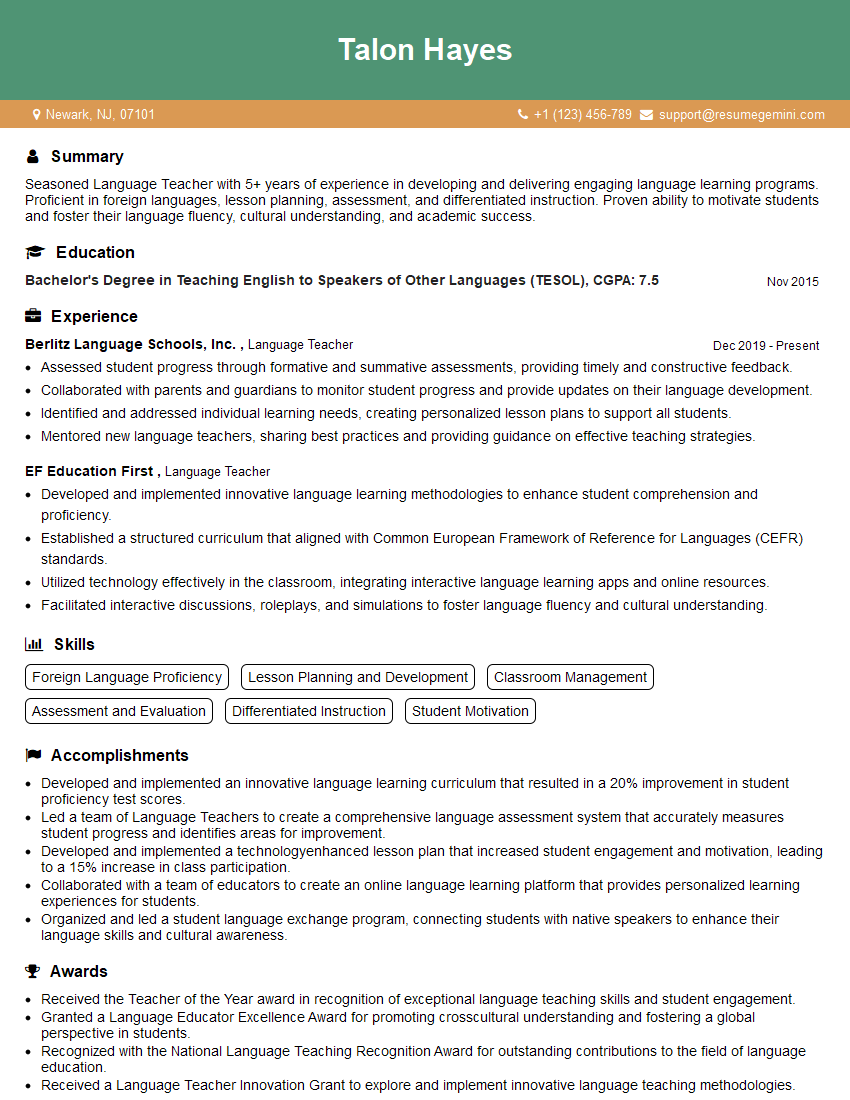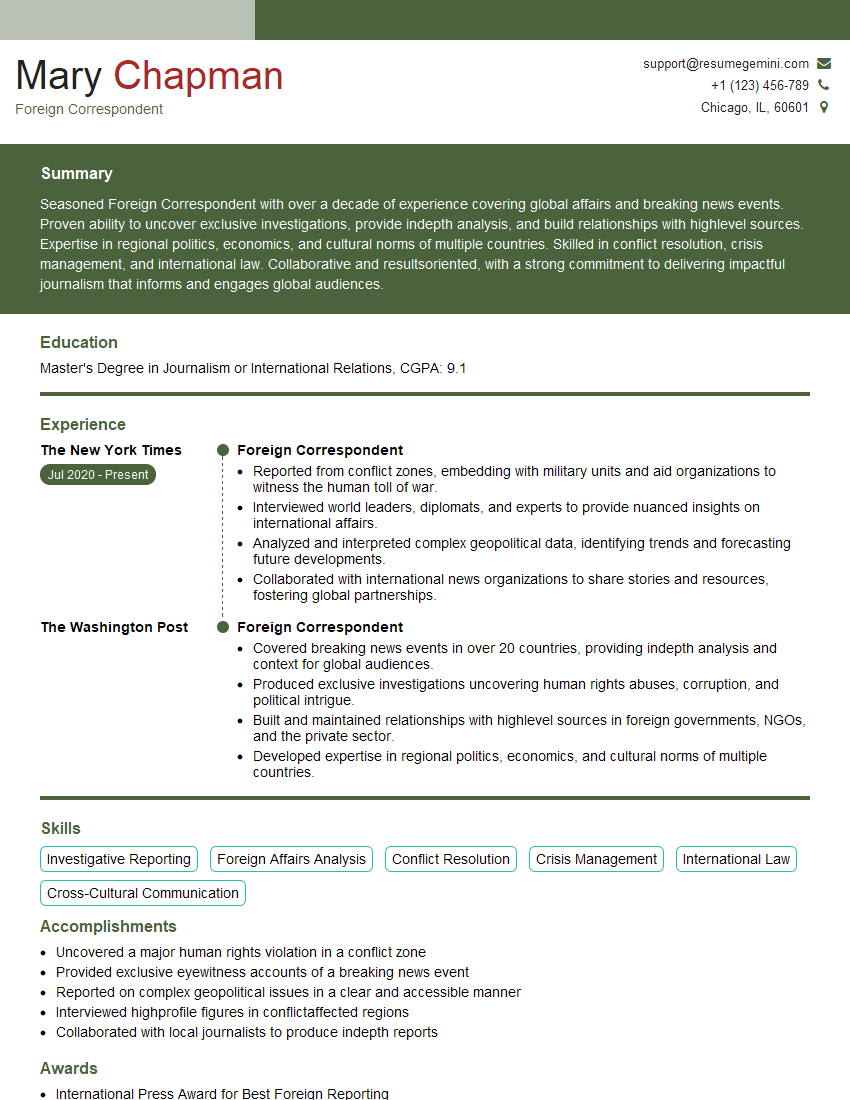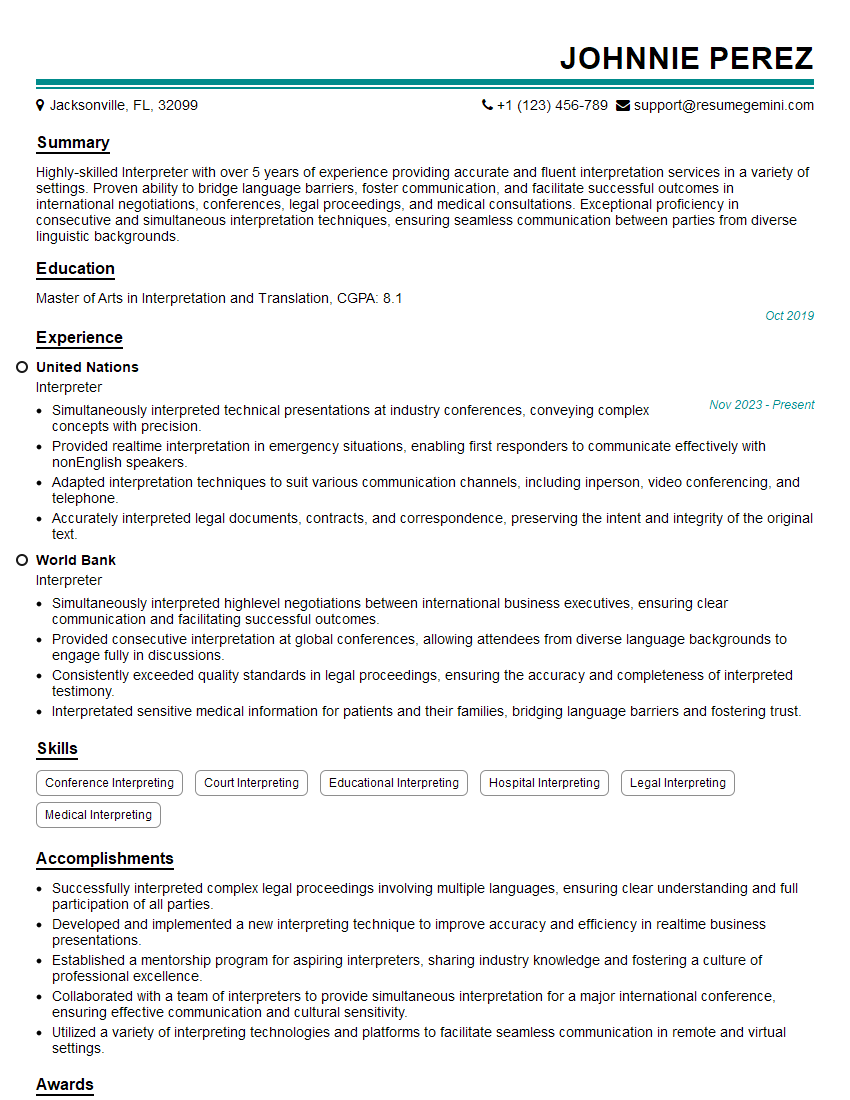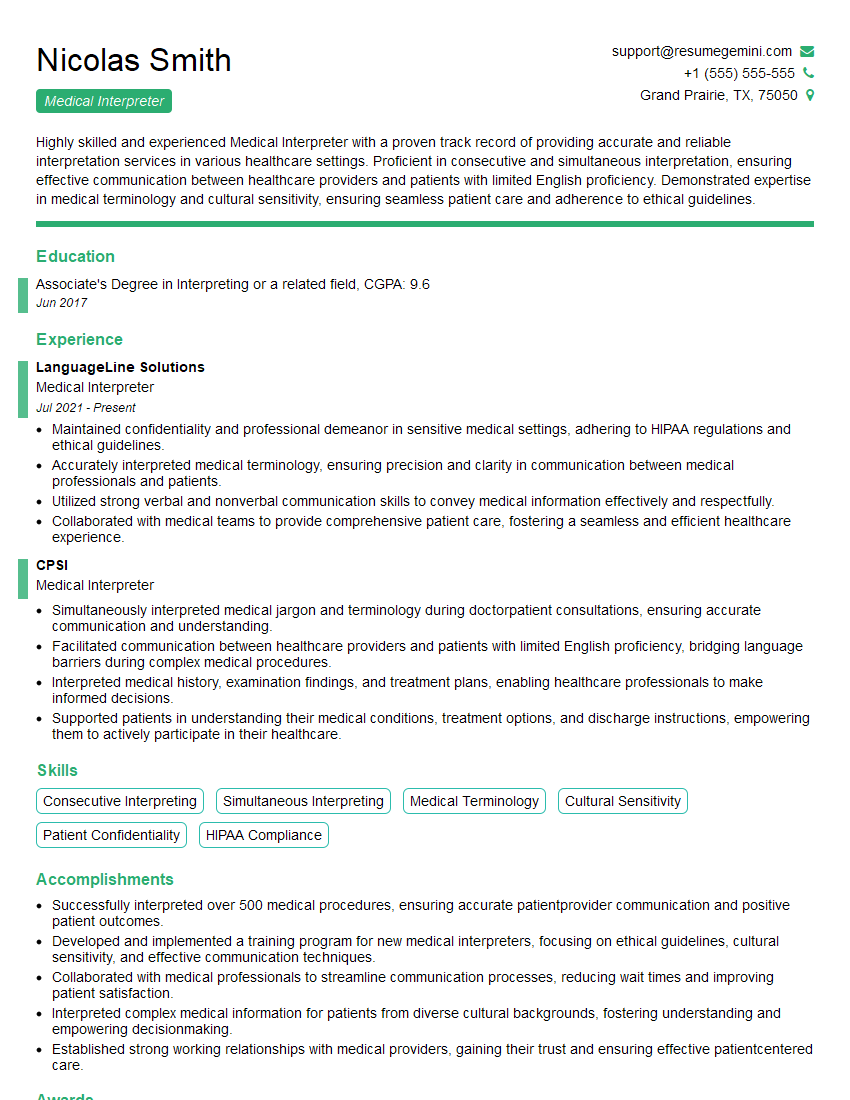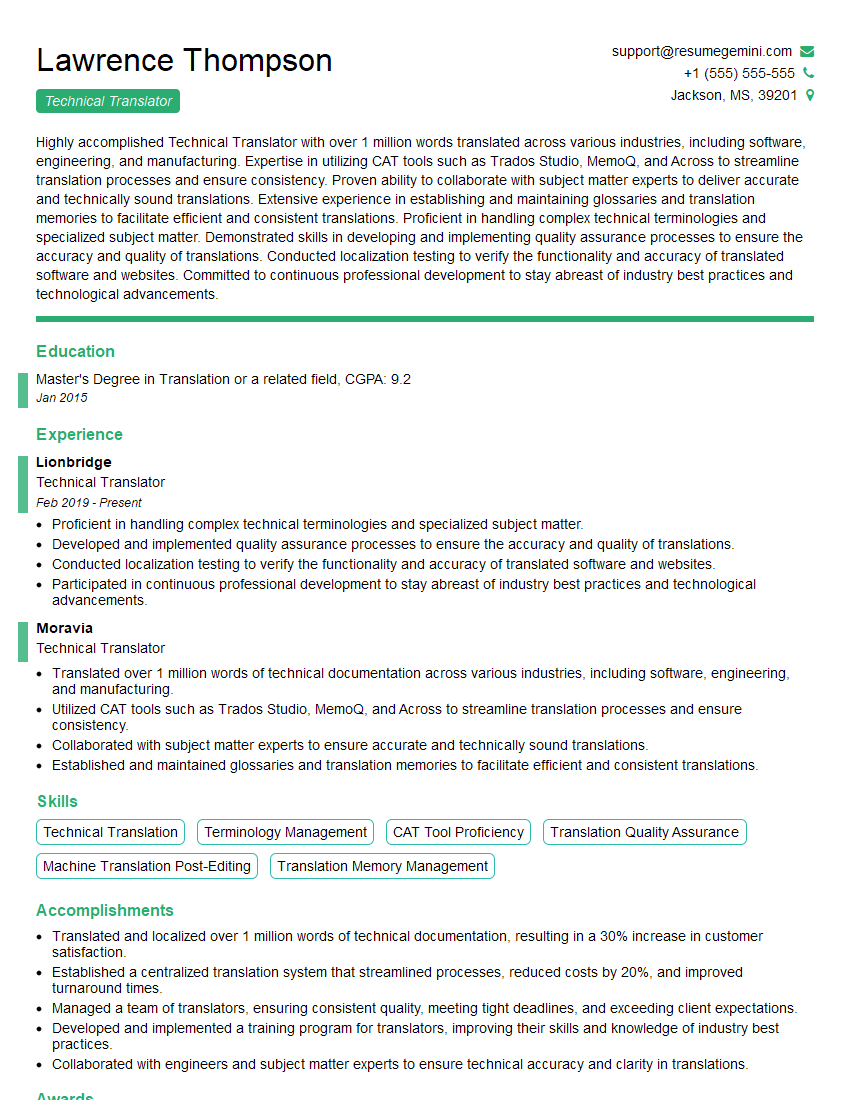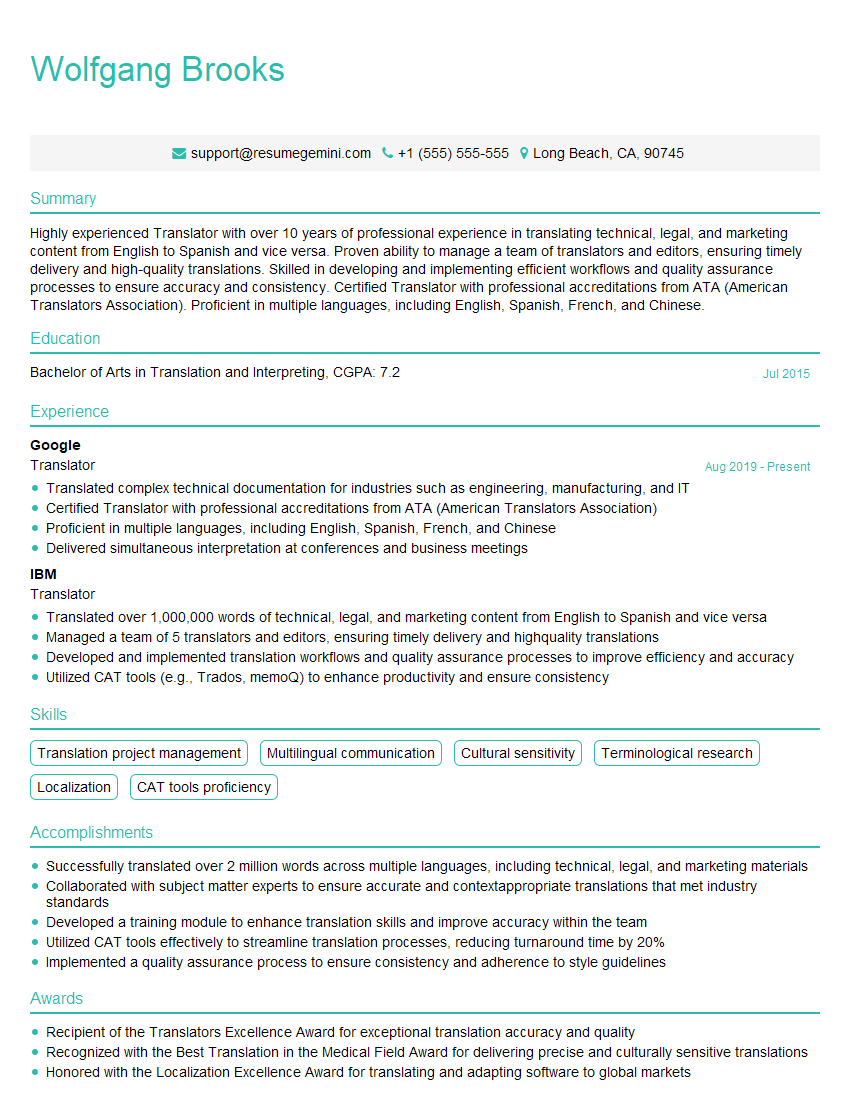Feeling uncertain about what to expect in your upcoming interview? We’ve got you covered! This blog highlights the most important Additional Languages (e.g., Spanish, French, etc.) interview questions and provides actionable advice to help you stand out as the ideal candidate. Let’s pave the way for your success.
Questions Asked in Additional Languages (e.g., Spanish, French, etc.) Interview
Q 1. What are the key differences between consecutive and simultaneous interpretation?
Consecutive and simultaneous interpretation are two distinct modes of interpreting, differing primarily in their timing and delivery. In consecutive interpretation, the interpreter waits for the speaker to complete a segment of speech – typically a sentence or a short paragraph – before rendering the interpretation. This allows for note-taking and more careful phrasing. Think of it like a relay race; the speaker finishes their leg, then the interpreter takes over. Simultaneous interpretation, on the other hand, is a real-time process. The interpreter renders the message almost instantaneously, while the speaker is still talking. It’s like a live, running commentary. This requires exceptional linguistic agility and mental processing speed.
- Consecutive: Better for complex or nuanced discussions, allows for greater accuracy and better note-taking for clarity.
- Simultaneous: More efficient for longer speeches or meetings where time is a constraint. Requires specialized training and equipment (like headsets).
For instance, consecutive interpretation might be suitable for a legal proceeding where precise wording is paramount, while simultaneous interpretation is common in international conferences with numerous speakers.
Q 2. Describe your experience with translation software (e.g., CAT tools).
I have extensive experience using Computer-Assisted Translation (CAT) tools, including SDL Trados Studio, MemoQ, and Across. These tools significantly enhance productivity and consistency in translation projects. They offer features such as:
- Translation Memory (TM): This stores previously translated segments, allowing for quick retrieval of consistent translations of repeated phrases or sentences. This is invaluable for ensuring consistency across large projects.
- Terminology Management: CAT tools allow for the creation and management of terminology databases, guaranteeing consistent use of specialized terms throughout a project. This is crucial for technical documents or marketing materials where precise terminology is essential.
- Quality Assurance (QA): Many CAT tools offer built-in QA checks, identifying potential inconsistencies, errors, and omissions. This helps to catch mistakes before they reach the client.
For example, in a recent technical translation project, the TM in SDL Trados Studio allowed me to reuse previously translated segments, accelerating the process and ensuring consistent use of technical terminology. The QA features helped identify and correct several minor errors, improving the overall quality of the final product.
Q 3. How do you handle a situation where you encounter an unfamiliar term during interpretation?
Encountering an unfamiliar term during interpretation is a common occurrence, and handling it professionally requires a multi-pronged approach. My first step is to politely ask for clarification from the speaker. This could involve asking for a definition, an explanation, or a synonym. If clarification isn’t immediately possible, I would use a descriptive paraphrase, explaining the context and the intended meaning to the best of my ability. For example, if the term is related to a specific field, I might explain it in layman’s terms or use a circumlocution. I may also try to infer the meaning from the context of the surrounding words. Lastly, I would make a note of the term for later research, ensuring I can accurately translate it in the future. This meticulous approach prioritizes accuracy and transparency while maintaining the flow of communication.
Q 4. Explain your approach to ensuring accuracy and consistency in translation projects.
Accuracy and consistency are paramount in translation. My approach involves a rigorous process encompassing several key steps:
- Thorough Research: Before starting a project, I conduct thorough research to understand the subject matter, target audience, and any specific terminology. This helps me choose the most appropriate and accurate language.
- Style Guide Adherence: I meticulously follow any provided style guides or glossaries to ensure consistency in terminology, formatting, and style. This is especially important for large projects with multiple translators.
- Multiple Revisions and Proofreading: I always conduct multiple revisions of my work, checking for accuracy, clarity, and consistency. I often employ a second proofreading pass to catch any missed errors.
- Leveraging CAT Tools: As mentioned previously, using CAT tools is integral to maintaining consistency by utilizing translation memories and terminology databases.
For example, in a marketing translation project, adhering to the client’s style guide helped maintain the brand’s voice and tone across all translated materials.
Q 5. How would you adapt your communication style when interacting with individuals from different cultural backgrounds?
Adapting communication style when working with individuals from diverse cultural backgrounds requires sensitivity and awareness. I strive to understand and respect cultural nuances in communication, including:
- Direct vs. Indirect Communication: Some cultures favor direct communication, while others prefer a more indirect approach. I adjust my style accordingly, ensuring my message is clearly understood while respecting cultural preferences.
- Nonverbal Communication: I pay close attention to nonverbal cues, such as body language and eye contact, which can vary significantly across cultures. This helps avoid misinterpretations and build rapport.
- Formal vs. Informal Language: I adjust my register appropriately, using formal language when necessary and a more informal tone in appropriate situations. This shows respect for cultural norms and creates a comfortable communication environment.
- Active Listening: I practice active listening, paying careful attention to what is being said and how it is being said, to ensure full understanding.
For instance, in a negotiation with a business partner from Japan, I adopted a more indirect communication style, focusing on building a relationship before discussing business matters, showing cultural sensitivity and respecting the Japanese emphasis on harmony and relationship building.
Q 6. What strategies do you employ to improve your fluency in your target language(s)?
Maintaining fluency in my target languages requires continuous effort. My strategies include:
- Immersion: I actively seek opportunities to immerse myself in the language, watching movies and television shows, listening to music and podcasts, and reading books and articles in my target languages. This helps maintain natural fluency and exposure to modern vernacular.
- Practice with Native Speakers: I regularly engage in conversations with native speakers, both professionally and informally. This allows for real-time feedback and practice in using the language naturally.
- Formal Study: I supplement immersion with formal study, focusing on grammar, vocabulary, and idiomatic expressions. This allows for focused learning and honing specific skills.
- Language Learning Apps: Utilizing language learning apps such as Duolingo or Babbel aids consistent daily practice and reinforces vocabulary and grammar.
For instance, watching Spanish-language films allows me to learn new vocabulary and colloquialisms while experiencing authentic cultural context.
Q 7. Describe a challenging translation project you’ve worked on and how you overcame the difficulties.
One particularly challenging project involved translating a highly technical legal document from French to English. The document was dense with specialized legal terminology, many of which lacked direct English equivalents. The challenge was to accurately convey the nuanced legal meanings while maintaining clarity and precision for a non-legal audience. To overcome these difficulties, I took the following steps:
- Extensive Legal Research: I conducted extensive research to understand the specific legal concepts and terminology within the document.
- Consultation with Legal Experts: I consulted with legal experts in both French and English law to ensure accurate interpretation and translation of complex legal terms and principles.
- Iterative Translation and Review: I employed an iterative translation process, reviewing and revising my work multiple times to ensure accuracy and clarity.
- Detailed Glossaries: I developed detailed glossaries of both French and English legal terminology to ensure consistent usage throughout the document.
The result was a clear and accurate translation that effectively conveyed the meaning and legal implications of the original French document to an English-speaking audience. This project highlighted the importance of thorough research, expert consultation, and iterative review in handling highly technical translation tasks.
Q 8. How do you manage time effectively when interpreting during a high-pressure situation?
Effective time management during high-pressure interpreting requires a combination of preparation, strategy, and mental agility. It’s like being a conductor of an orchestra – you need to keep all the instruments (different parts of the speech) in harmony and on time.
- Preparation: Before any assignment, I thoroughly review materials, familiarize myself with the subject matter, and anticipate potential challenges. Knowing the context allows for quicker comprehension and more fluid interpretation.
- Active Listening & Note-Taking: I employ efficient note-taking techniques, focusing on key concepts and keywords, not verbatim transcription. This helps me stay focused and manage information flow. I use a system of abbreviations and symbols tailored to the language pair. For example, in Spanish, I might use ‘xq’ for ‘porque’ (because) to save time.
- Strategic Pauses & Summaries: I strategically use brief pauses to process information, especially during complex or technical passages. I also incorporate concise summaries to ensure both speakers and listeners are on the same page. This avoids information overload for all parties involved.
- Mental Flexibility: Unexpected interruptions or changes in the conversation are common. I’m trained to quickly adapt, prioritize information, and adjust my interpretation accordingly. It’s about reacting swiftly and intelligently.
Q 9. What are your preferred methods for researching and verifying the accuracy of translations?
Accuracy is paramount. My verification process involves a multi-step approach, much like a detective investigating a case.
- Reference Materials: I start by consulting reputable dictionaries, glossaries, and specialized terminology databases relevant to the subject matter. For example, if translating a medical text, I would refer to medical terminology dictionaries and guidelines.
- Cross-referencing: I compare my translation against other reliable sources, including previous translations of similar texts (if available), to ensure consistency and accuracy. It’s like double-checking my work with a peer review.
- Subject Matter Experts (SMEs): For highly technical or specialized texts, I often consult with SMEs to clarify ambiguities or verify the accuracy of terminology. Their expertise ensures the translation reflects the nuances of the field.
- Contextual Analysis: I consider the overall context to understand the intended meaning. A single word can have multiple meanings, so context is crucial for avoiding misinterpretations. Imagine translating ‘bank’ – it could be a financial institution or the side of a river.
Q 10. How do you maintain confidentiality when working with sensitive information in a bilingual setting?
Confidentiality is non-negotiable. I treat all sensitive information with the utmost discretion, similar to the confidentiality expected in a doctor-patient relationship.
- Non-Disclosure Agreements (NDAs): I always carefully review and sign NDAs before starting any project involving sensitive data. This legally protects both the client and myself.
- Secure Data Handling: I use secure storage methods for all documents and electronic files, including password-protected computers and encrypted drives. I avoid using public Wi-Fi or unsecured networks when handling sensitive information.
- Limited Access: I restrict access to sensitive information to only authorized personnel and never discuss project details in public areas. Imagine keeping your keys to the vault only in your control.
- Data Destruction: After completing a project, I securely delete all sensitive data from my systems according to the client’s guidelines. This ensures no trace of the information is left behind.
Q 11. What are some common pitfalls to avoid when translating technical documentation?
Technical documentation translation requires precision and a deep understanding of both the source and target languages, as well as the technical field itself. Common pitfalls to avoid include:
- Ignoring Cultural Nuances: Technical terms might not have direct equivalents. For example, certain measurement units (e.g., metric vs. imperial) or technical standards need adapting to the target culture.
- Lack of Subject Matter Expertise: Attempting to translate complex technical documents without a solid understanding of the subject matter can lead to inaccuracies and misinterpretations. It is vital to know the terminology.
- Over-literal Translation: A word-for-word approach often fails in technical contexts because it may not capture the intended meaning. Think of it like trying to translate a recipe directly – some units or instructions need adjustment for cultural context.
- Inconsistency in Terminology: Using different words for the same concept throughout the document is confusing and unprofessional. Maintain a consistent glossary throughout the document.
- Neglecting Formatting: Technical documents often rely heavily on formatting for clarity (tables, diagrams, etc.). Maintaining proper formatting is crucial for preserving the original document’s structure and ease of use.
Q 12. How would you address inconsistencies in terminology between different source materials?
Inconsistencies in terminology are a frequent challenge. My approach is systematic and ensures clarity.
- Identify and Document: First, I thoroughly review all source materials, systematically identifying any discrepancies in terminology. I create a list of the conflicting terms and their various uses.
- Contextual Analysis: I analyze the context of each usage to understand the intended meaning behind each variant. Is there a subtle difference in meaning, or is it just inconsistent usage?
- Establish a Standard: Based on my analysis, I select a preferred term for consistency. My choice considers factors like frequency of use, clarity, and adherence to established standards (e.g., industry-specific terminology).
- Create a Glossary: I develop a comprehensive glossary that defines all terms and their chosen variants, including notes about any contextual nuances. This ensures consistency throughout all future translations of related materials.
- Client Consultation: If there is significant ambiguity, I consult with the client to discuss my findings and proposed solution to ensure alignment with their preferences and the overall project goals.
Q 13. Describe your experience with various translation memory tools and their benefits.
Translation memory (TM) tools are invaluable for efficiency and consistency. I have extensive experience with several leading TM tools, including SDL Trados Studio, MemoQ, and Across.
- Improved Efficiency: TM tools store previously translated segments, which can be automatically reused in new projects. This significantly reduces translation time and effort, especially for repetitive terminology or phrases.
- Enhanced Consistency: Using a TM ensures consistent terminology across multiple projects, eliminating discrepancies and improving overall quality. Imagine a style guide, but for translations.
- Reduced Costs: By automating repetitive tasks, TM tools can reduce the overall cost of translation projects.
- Quality Assurance: TM tools also provide features for quality assurance, including automated checks for consistency, terminology accuracy, and potential errors.
- Project Management: Many TM tools also offer project management capabilities, helping to streamline workflows and collaborate more effectively with clients and colleagues.
Q 14. How proficient are you in various dialects or regional variations of your target language?
My proficiency in dialects and regional variations depends on the target language. For instance, in Spanish, I am well-versed in the major dialects (e.g., Castilian, Mexican, Colombian), understanding the grammatical and vocabulary differences. My approach incorporates a contextual approach, taking into consideration the intended audience and regional context of the project. I am able to adapt my style of translation to ensure accurate and appropriate communication. For example, I would use different vocabulary and phrasing when translating for a Mexican audience than I would for a Spanish audience in Spain.
For French, my expertise includes understanding the differences between European French and Canadian French, recognizing variations in pronunciation and vocabulary, so I can adapt my translations effectively. In this way, I can appropriately convey the meaning and cultural context for specific groups within a language. This is crucial for ensuring successful communication and avoid potential misunderstandings.
Q 15. What is your approach to quality assurance in translation and interpretation?
My approach to quality assurance in translation and interpretation is multifaceted and prioritizes accuracy, consistency, and cultural appropriateness. It begins even before the translation process starts—with a thorough understanding of the source text and its intended audience. This includes identifying the purpose, tone, and style required.
- Pre-translation review: I meticulously analyze the source text for ambiguities, inconsistencies, and potential cultural sensitivities.
- Translation process: I employ various techniques depending on the text type, including using terminology databases, consulting subject matter experts when needed, and utilizing CAT tools (Computer-Assisted Translation) for consistency and terminology management.
- Self-editing and proofreading: I perform multiple rounds of self-editing, focusing on grammar, style, and accuracy. This is followed by a rigorous proofreading stage to identify any remaining errors.
- Quality control checklist: I use a comprehensive checklist to ensure adherence to style guides, terminology consistency, and overall quality. This checklist is tailored to the specific project requirements.
- Post-translation review: Where possible, I engage a second, independent reviewer for a final quality check, particularly for crucial documents. This ensures a fresh perspective and catches errors I might have missed.
This layered approach ensures that the final product meets the highest standards of quality and accuracy, reflecting my commitment to delivering exceptional service.
Career Expert Tips:
- Ace those interviews! Prepare effectively by reviewing the Top 50 Most Common Interview Questions on ResumeGemini.
- Navigate your job search with confidence! Explore a wide range of Career Tips on ResumeGemini. Learn about common challenges and recommendations to overcome them.
- Craft the perfect resume! Master the Art of Resume Writing with ResumeGemini’s guide. Showcase your unique qualifications and achievements effectively.
- Don’t miss out on holiday savings! Build your dream resume with ResumeGemini’s ATS optimized templates.
Q 16. Explain your understanding of linguistic nuances and cultural context in translation.
Understanding linguistic nuances and cultural context is paramount in translation. A direct, word-for-word translation often fails to capture the true meaning and intended effect of the source text. Linguistic nuances encompass idioms, colloquialisms, figures of speech, and subtle differences in word meaning that can significantly alter the message. For instance, a seemingly simple phrase like “break a leg” in English, would require a completely different, culturally appropriate equivalent in another language.
Cultural context is equally vital. It involves considering the target audience’s cultural background, values, and social norms. A translation that is perfectly acceptable in one culture might be offensive or incomprehensible in another. For example, humor, religious references, or even color symbolism can vary widely across cultures, requiring careful adaptation in the translation.
I approach this by conducting thorough research on the target culture and audience before starting the translation. I pay close attention to connotations and implications of words and phrases, ensuring the translated text conveys the same meaning and tone while remaining culturally appropriate and engaging for the intended audience.
Q 17. How do you handle requests for revisions or corrections to your translations?
I welcome revisions and corrections as an integral part of the translation process. They contribute to delivering a superior final product. My response to revision requests follows a structured approach:
- Careful review: I carefully review all feedback provided, considering the context and rationale behind each suggestion.
- Open communication: I maintain clear and open communication with the client to discuss any points of disagreement or clarification needed. I explain the linguistic or cultural reasoning behind my initial choices where appropriate.
- Prompt implementation: I promptly implement the agreed-upon revisions, ensuring accuracy and consistency throughout the entire text.
- Documentation: I maintain detailed records of all revisions and corrections, allowing for easy tracking and future reference.
My goal is to collaborate with the client to ensure their complete satisfaction with the final translation, incorporating all necessary changes while maintaining the highest standards of quality and accuracy.
Q 18. Describe your experience with different translation methodologies (e.g., direct, indirect).
I have experience with both direct and indirect translation methodologies. Direct translation involves translating the source text directly into the target language, word by word or phrase by phrase. It’s often suitable for texts with straightforward language and minimal cultural implications.
Indirect translation, on the other hand, involves an intermediate language. This is particularly useful when the source and target languages are significantly different, or when the translator lacks fluency in one of the languages involved. For instance, translating a text from German to Japanese might involve using English as an intermediate language if my expertise lies primarily in German-English and English-Japanese translation.
My choice of methodology depends on various factors, including the complexity of the text, the source and target languages, and the project requirements. I always prioritize the most efficient and accurate approach to ensure the best possible outcome.
Q 19. How familiar are you with international translation standards (e.g., ISO 17100)?
I am familiar with international translation standards, particularly ISO 17100, which specifies the requirements for translation services. This standard covers various aspects of the translation process, from the qualification of translators to the management of translation projects. Understanding ISO 17100 helps ensure consistent quality and transparency throughout the translation lifecycle.
My familiarity with ISO 17100 extends to practical application. For example, I am adept at using terminology management tools to maintain consistency, and I diligently adhere to quality assurance processes to ensure the final product meets the required standards. My commitment to these standards reflects a dedication to professionalism and client satisfaction.
Q 20. How do you adapt your language skills to different communication mediums (e.g., written, oral)?
Adapting my language skills to different communication mediums requires a nuanced approach. Written translation necessitates precision, clarity, and adherence to grammatical rules. Oral translation (interpretation) demands fluency, quick thinking, and the ability to convey meaning accurately and naturally in real-time.
For written translation, I focus on crafting clear and concise sentences that resonate with the target audience. I meticulously review and edit my work to eliminate any ambiguities or grammatical errors. In oral translation, I focus on clear articulation, effective pacing, and conveying the nuances of the speaker’s message accurately. I adapt my style to different contexts, using formal language for professional settings and informal language where appropriate. I practice active listening, anticipating the speaker’s message, and quickly translating it to convey the original meaning and intent. The key is adaptability and a deep understanding of both languages in both written and spoken contexts.
Q 21. Describe a time you had to interpret a complex technical concept into a simpler language.
I once had to translate a complex technical document on advanced semiconductor manufacturing processes for a non-technical audience. The original document was dense with jargon and highly specialized terminology. My task was to create an accessible and understandable summary for a group of investors with limited technical knowledge.
To achieve this, I adopted a multi-step approach:
- Thorough understanding: I first spent time thoroughly understanding the technical concepts myself, using external resources and consulting with an expert if needed.
- Simplifying language: I replaced technical jargon with plain language equivalents, using clear and concise definitions where necessary.
- Analogies and metaphors: I utilized simple analogies and metaphors to explain complex concepts. For example, I explained the process of chip fabrication by comparing it to a layered cake with each layer representing a different component.
- Visual aids: I suggested the inclusion of diagrams and illustrations to enhance comprehension and make the information more accessible.
The result was a concise and engaging summary that effectively communicated the key aspects of the technology to the non-technical audience without compromising accuracy. The feedback was overwhelmingly positive, highlighting the success of this approach in bridging the communication gap.
Q 22. How would you handle a situation where there is a significant difference in communication style between two parties?
Handling differing communication styles requires empathy and adaptability. Think of it like navigating different cultures – even within the same language. Some cultures are direct, others indirect. Some value formality, others informality.
My approach is threefold:
- Active Listening: I carefully observe both parties’ verbal and nonverbal cues. This includes body language, tone of voice, and choice of words. Are they using formal or informal language? Are they direct or indirect in their communication?
- Clarification and Summarization: I regularly ask clarifying questions to ensure understanding. I also summarize key points to confirm agreement and identify any misunderstandings. For instance, if one party uses idioms the other doesn’t understand, I would explain them clearly.
- Mediation (when necessary): If necessary, I gently guide the conversation towards a more productive interaction, emphasizing mutual respect and understanding. This might involve suggesting alternative phrasing or pointing out potential misunderstandings due to cultural differences. For example, if one person is interrupting frequently, I might politely suggest that everyone take turns speaking.
Ultimately, successful cross-cultural communication is about building bridges, not walls. It’s about acknowledging differences and finding common ground.
Q 23. What are some effective strategies for improving your cross-cultural communication skills?
Improving cross-cultural communication skills is a continuous process of learning and self-reflection. It involves a combination of knowledge acquisition, practical application, and a commitment to ongoing improvement.
- Cultural Awareness Training: Formal training programs provide valuable insight into different communication styles, customs, and etiquette. This could involve workshops, online courses, or even cultural immersion experiences.
- Immersion and Experience: Spending time in different cultural contexts – through travel, interaction with diverse communities, or working on international projects – is invaluable. This provides firsthand exposure to different communication patterns.
- Language Learning: Proficient language skills are crucial. Being able to communicate effectively in another language demonstrates respect and facilitates deeper understanding.
- Empathy and Open-mindedness: Cultivating empathy and being open to different perspectives are vital. This involves actively listening, suspending judgment, and being willing to learn from others.
- Self-Reflection: Regularly reflecting on your own communication style and biases is key. Understanding your own cultural lens is crucial for effective cross-cultural interaction.
For example, I once worked with a team from Japan, where direct confrontation is often avoided. Understanding this cultural nuance allowed me to adapt my communication style to be more indirect and collaborative.
Q 24. How do you stay updated on changes and trends in the field of translation and interpretation?
Staying current in translation and interpretation requires a proactive approach. The field is constantly evolving, with new technologies and linguistic trends emerging regularly.
- Professional Organizations: Membership in organizations like the American Translators Association (ATA) or similar international bodies provides access to journals, conferences, webinars, and networking opportunities.
- Industry Publications and Journals: Staying informed about the latest technologies and best practices requires reading relevant publications and journals. These often feature articles on new translation tools, linguistic research, and industry trends.
- Online Resources and Blogs: Many online resources, blogs, and forums discuss current issues and debates within the translation and interpretation field. These often offer valuable insights from experienced professionals.
- Continuing Education: Engaging in continuing education courses and workshops helps to maintain proficiency and acquire new skills. This could include specialized training in specific software, areas of expertise, or new translation technologies.
- Networking: Networking with other translators and interpreters is essential. Conferences, workshops, and online forums provide opportunities to exchange information and learn from peers.
For instance, I recently attended a workshop on machine translation post-editing, a rapidly growing area that requires specialized skills.
Q 25. How would you deal with a situation where you are unsure of the meaning of a word or phrase?
When encountering an unknown word or phrase, my approach emphasizes accuracy and context. I never guess; instead, I use several strategies.
- Consult Dictionaries and Resources: I immediately consult specialized dictionaries, terminology databases, and online resources, taking into account the specific context of the word or phrase.
- Research the Context: I thoroughly analyze the surrounding text or conversation to infer the meaning from the context. This could involve looking at previous sentences or paragraphs.
- Seek Clarification: If possible, I politely ask the speaker for clarification. In an interpretation setting, I might ask the speaker to rephrase or provide a synonym.
- Subject Matter Expertise: Leveraging my subject matter knowledge can be crucial. Understanding the overall topic helps contextualize unfamiliar terms.
- Collaboration (when appropriate): If the situation allows, I might consult with a colleague or subject matter expert for assistance.
For example, if I encountered a highly technical term in a medical document, I would consult a medical dictionary and cross-reference it with the surrounding text to ensure accuracy before translating it.
Q 26. Describe your experience with interpreting for people with different levels of language proficiency.
Interpreting for individuals with varying language proficiency requires adaptability and sensitivity. My experience has shown that effective communication hinges on adjusting my approach to meet the listener’s needs.
With individuals having limited proficiency, I employ:
- Simplified Language: I use simpler sentence structures and vocabulary, avoiding complex grammatical constructs or idioms.
- Visual Aids: Where appropriate, I incorporate visual aids like diagrams or pictures to enhance understanding.
- Slow and Clear Speech: I speak slowly and clearly, enunciating carefully.
- Frequent Check-ins: I regularly pause to check for understanding and ask clarifying questions.
With fluent speakers, I maintain a more natural pace and complexity, focusing on conveying the nuance and subtleties of the original message.
For instance, I’ve interpreted for medical consultations, where explaining complex diagnoses to patients with limited healthcare vocabulary requires a significantly different approach compared to interpreting a business meeting between fluent professionals.
Q 27. What are the ethical considerations involved in translation and interpretation work?
Ethical considerations are paramount in translation and interpretation. Maintaining integrity and objectivity is crucial. Key ethical considerations include:
- Confidentiality: Maintaining the strictest confidentiality of all information shared during the translation or interpretation process is essential. This is especially relevant in sensitive contexts like legal or medical settings.
- Accuracy and Fidelity: Translators and interpreters must strive for accuracy and fidelity to the source text or speech, without adding their own opinions or interpretations.
- Impartiality and Objectivity: It’s crucial to remain impartial and objective, avoiding any bias or influence that could compromise the accuracy or fairness of the translation or interpretation.
- Professional Competence: Only undertaking assignments within the scope of one’s professional competence is essential. Accepting projects requiring specialized knowledge beyond one’s capabilities would be unethical.
- Transparency and Disclosure: Any potential conflicts of interest must be disclosed. For example, if a translator has a personal relationship with one of the parties involved.
Ethical breaches can have serious consequences, ranging from damage to reputation to legal repercussions. Maintaining the highest ethical standards is crucial for building trust and credibility.
Q 28. How do you prioritize accuracy and fluency when working under tight deadlines?
Balancing accuracy and fluency under tight deadlines requires a strategic approach and efficient workflow.
- Prioritization: I carefully prioritize the most critical aspects of the text or speech, ensuring that the most essential information is conveyed accurately and fluently, even if minor details must be slightly condensed.
- Time Management: Effective time management is key. Creating a realistic timeline and sticking to it helps avoid rushed work.
- Efficient Tools and Technologies: Leveraging CAT tools (Computer-Assisted Translation) and other technological aids can significantly increase efficiency.
- Strategic Simplification: Sometimes, slight simplifications in language may be necessary to meet deadlines without compromising accuracy significantly. This requires careful judgment and awareness of the context.
- Proofreading and Editing: Even with tight deadlines, thorough proofreading and editing are essential to catch errors and ensure clarity and accuracy.
For example, if I’m interpreting a live presentation under a tight deadline, I might focus on conveying the main points accurately and fluently, potentially summarizing minor details rather than translating them verbatim.
Key Topics to Learn for Additional Languages (e.g., Spanish, French, etc.) Interview
- Grammar and Syntax: Deep understanding of grammatical structures, tenses, and sentence construction. Practice applying these rules in various contexts.
- Vocabulary and Idioms: Build a robust vocabulary relevant to your target industry. Familiarize yourself with common idioms and expressions to sound natural and fluent.
- Cultural Nuances: Understand the cultural context of the language. This includes awareness of social etiquette and potential communication differences.
- Reading Comprehension: Practice reading texts in the target language to improve comprehension and identify key information quickly.
- Oral Communication: Develop clear and concise speaking skills. Practice describing your experiences and skills fluently in the target language.
- Writing Proficiency: Practice writing professional emails, reports, or other documents relevant to your field in the target language. Focus on clarity and accuracy.
- Listening Comprehension: Enhance your ability to understand spoken language, including accents and different speaking speeds. Practice active listening skills.
- Translation and Interpretation (if applicable): If your role involves translation or interpretation, focus on accuracy and conveying meaning effectively.
- Problem-Solving in the Target Language: Practice solving hypothetical work-related problems while communicating your thought process clearly in the target language.
Next Steps
Mastering additional languages significantly enhances your career prospects, opening doors to global opportunities and higher earning potential. A strong command of a second language showcases adaptability, cultural sensitivity, and advanced communication skills—highly valued attributes in today’s competitive job market. To maximize your chances of landing your dream role, creating a compelling and ATS-friendly resume is crucial. ResumeGemini is a trusted resource to help you build a professional and impactful resume that highlights your language skills effectively. We provide examples of resumes tailored to showcase proficiency in Additional Languages (e.g., Spanish, French, etc.) to help you craft a winning application.
Explore more articles
Users Rating of Our Blogs
Share Your Experience
We value your feedback! Please rate our content and share your thoughts (optional).
What Readers Say About Our Blog
Interesting Article, I liked the depth of knowledge you’ve shared.
Helpful, thanks for sharing.
Hi, I represent a social media marketing agency and liked your blog
Hi, I represent an SEO company that specialises in getting you AI citations and higher rankings on Google. I’d like to offer you a 100% free SEO audit for your website. Would you be interested?
